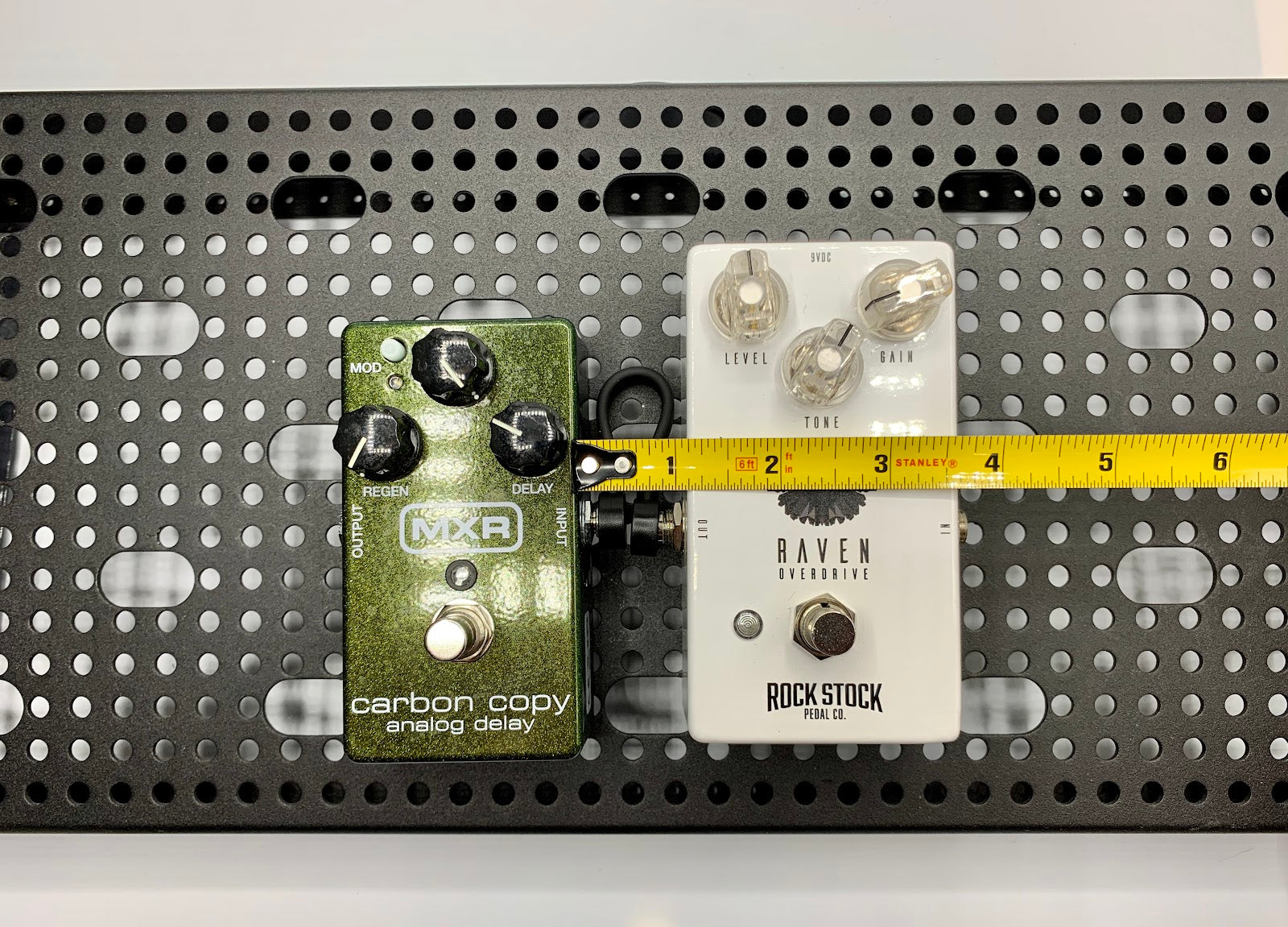The Best Patch Cables For Guitar Pedal Boards

Instrument cables are like motor oil in your car; most people don’t think much about them and use a cheap option. But just like a quality motor oil will give you better engine performance, quality cables will give you better audio performance.
This is what those $300 pickups and $2k worth of pedals run through after all. Buying cheap cables hinders the full audio potential of those pedals. It’s like buying a Ferrari and throwing off brand motor oil in it. Yeah it works, but only just.
I’ve already talked extensively about cables in general, so today I want to dive a little deeper into cables specifically for your pedalboard.
What Makes A Good Patch Cable?

I highly recommend checking out the article I mentioned earlier, but here’s the 25 cent version of that.
Good cables have a high purity stranded copper core. The high purity means better conductivity, which leads to less impedance. They also have a well wrapped or braided high purity copper shielding. The better the wrap and braid, the better the shielding is from outside interference. Between these you’ll have a couple insulator layers that discharge static electricity and provide additional shielding.
Then you have your outer layer, jackets (also called strain relief), and your connectors. Good cables use higher purity copper cores and shielding. This is expensive to manufacture so they’ll be more expensive. They also carry your signal better and with less impedance which translates to a better signal, and ultimately tone. Because the shielding layer is well wrapped or even braided, they’ll have less interference and will last longer.
Cheaper cables use copper cores and shielding with less purity. This creates more impedance to your signal, and can “choke” your tone. You’ll see if first with treble loss, and your signal can sounds a little weak (both in volume and tone).
Remember, cable runs are really only good up to about 25 feet before you lose tone. Think of the length of your cable from your guitar to your pedal board, all the 6 inch cables connecting your pedals, and the cable going from your pedal board to your amp. That’s a long way for your guitar’s signal to travel. Adding more impedance via cheaper cables will only add to this.
Buffers do a lot to help here. And I wrote about them in The Ultimate Guide To Guitar Pedal Signal Chain. But using another car analogy, think about that Ferrari. If they spent all of their time thinking only about the engine and transmission, and didn’t care about aerodynamics, the car would literally be hindered from its full speed potential via wind resistance.
That wind resistance here is electrical impedance via cheap cables. Sure, the engine (or buffer pedal) will do a lot of work, but that car (or full signal flow) is not living up to its full potential.
(And I promise that will be the last car analogy. Onto woodworking analogies!)
The Best Connectors For Patch Cables
Connectors (or jacks) come in a variety of shapes. For pedals, most people use 90 degree connectors to maximize their pedal board space. Here are the primary connectors you’ll see out in the wild.
Switchcraft Style Connectors

The Switchcraft style connectors are what you’re most likely familiar with. They’re the chrome or nickel plated connectors that are often seen with a blue strain relief (because as we all know, the color blue sounds the best). These connectors are well made, easy to repair, and are plentiful in stores and e-stores everywhere. My only objection to the Switchcraft style connectors is they take up a touch too much space. This is especially so if you have pedals with jacks at the same spot (like the sides) and can’t offset the pedal array.
Neutrik Style Connectors

Neutrik style patch cable connectors are very similar to the Switchcraft style connectors, but a little more heavy duty. This heft gives your connectors longer longevity, and they can take more abuse. The downside to the extra heft is that it means the connectors are larger, taking up more space on you pedal boards. I love these for instrument cables, but they’re not quite my tempo for pedal boards.
Pancake Connectors

As the name implies, they’re as thin as a diner pancake and kind of resemble the shape too.

The top benefit is being able to smush your pedals close enough together that it’s almost uncomfortable (and illegal in some states). If you have any size pedal board you can make the most of your space by using these connectors. These are broadly in the category of flat connectors.
These are perfect for any pedal configuration. Whether your pedals’ jacks are offset from one pedal to another, perfectly aligned (like a row of Boss pedals), or are all sorts of wonky and all over the place with jack location, these are likely to be a great connector for your patch cables.
One new spin on these is a squared version. These are even more compact than pancake connectors and still provide the same benefits.

Flat Patch Cables

If you want an even thinner version of a pancake style connector, then flat patch cables are your new best friend. These make your pedals as close as they can get without being in the same enclosure.
They’re not typically repairable, but if you buy a quality cable (not a cheap version on Amazon) you wont need to worry about it. Because of the manufacturing process and design, they’re hard to break. Similarly with the pancake connectors, they’re small enough to save you room even when the jacks are lined up.
S-Shape vs C-Shape Patch Cables
Patch cables with pancake connectors come in two configurations: S-Shape and C-Shape. A C-Shape cable is what most people have. If you were to fold your cable like a taco, the connector tips would touch. These are perfect for connecting pedals that have the jacks on the same side, whether that’s the side or top.

S-Shape Cables are a little different. They have one tip “turned around” from the typical C-Shape patch cable.

They’re the exact same components, just a different configuration. These are great for when you’re connecting a pedal with a side jack to a pedal with a top jack.
Having both on hand is useful if your pedals vary in the input/output jack location. The S-Style patch cable can get into those awkward positions without twisting the cable around. This helps keep your C-Shape cables from crimping and ultimately failing.
Gold Plated Connectors
There’s been a debate ever since I can remember about whether or not gold plated connectors are better than nickel plated connectors. I remember seeing the Monster cables display at GC and I swear you would always find two sales reps arguing about it.
I haven’t seen or heard any evidence of audio quality. Gold is conductive comparably to nickel. But the biggest benefit I’ve experienced is gold doesn’t tarnish.
I’ve never seen anyone wipe down their cables or connectors after gigs, so sweat, dirt, and oil builds up on these cables causing corrosion over time. With gold connectors this doesn’t really cause issues. You get a longer potential life out of gold, assuming you have quality connectors that won’t fall apart (not just cheap connectors that are gold plated). Even if you don’t really take care of them.
What about DIY Solderless Patch Cables?
Companies like GL and Emerson make some really good solderless connectors (and cable kits). These are awesome for how effortless they are. The only tool you need is a screwdriver. No soldering iron to heat up, solder to use, or even cables to prepare.
Here’s a video showing how easy they are to make, and how they work.
One great thing about these, besides how easy they are to make, is that you can customize the cable length to fit your board perfectly.

My main concern with these is longevity. They’re secure, but I'm a “screw and glue” kind of guy (I was serious about the woodworking metaphors). Since the attachment is merely a fastening, not a bonding process like a good solder job, I question the amount of use and abuse these cable terminations can take. The other downside is that unless you stagger them, which depends highly on the size your pedals, they can take up a lot of space when using side-mounted jacks.

Why Flat Patch Cables Are Better For Pedal Boards
We talked about a lot of patch cables. But which one should you get?
The entire reason I have a pedal board is to put pedals on it. The more I can fit, the happier I am. Standard patch cables, like Neutrik or Switchcraft style, take up a considerable amount of space. You can get around this by staggering your pedals so the jacks don’t line up (that’s a free pro tip by the way), or turn them at all sorts of angles like you’re playing Tetris.
Space is still going to be an issue though. Because the connectors still protrude really far out, meaning your max pedal potential is still lower than it could be. Even with staggering.
Let’s take a look at a couple pictures. The first picture is two pedals with the jacks lined up, using pancake connectors.


That’s a lot of space between the pedals (1” 3/16” to be exact). Let’s see what that looks like with the jacks staggered (not that you can do that for every pedal on your board):


Better (now we’re at ¾”), but we can still narrow that gap. Let’s replace them with flat patch cables.
First with the jacks lined up, and then staggered.




When staggering the flat cables we’re down to only ⅝” between pedals, and because the flat patch connectors are so much smaller than pancake connectors you can stagger them quite easily without losing space above or below your current pedal row. Imagine your whole pedal board using flat patch cables with your pedals nearly touching. Not to mention utilizing S-style cables and C-style cables to accommodate different jack configurations like the side mount to top mount setup pictured below.

If you really want to maximize the space on your pedal board, and have an excuse to buy more pedals, then flat patch cables are the way to go.
So with that in mind, here’s a few recommendations of great flat patch cables:
Rock Stock Pedals - The new kids on the block making good waves.
EBS - The first to do flat patch cables!
Ernie Ball - The trusted name in guitar and bass accessories.
Rockboard – Exceptional patch cables.

